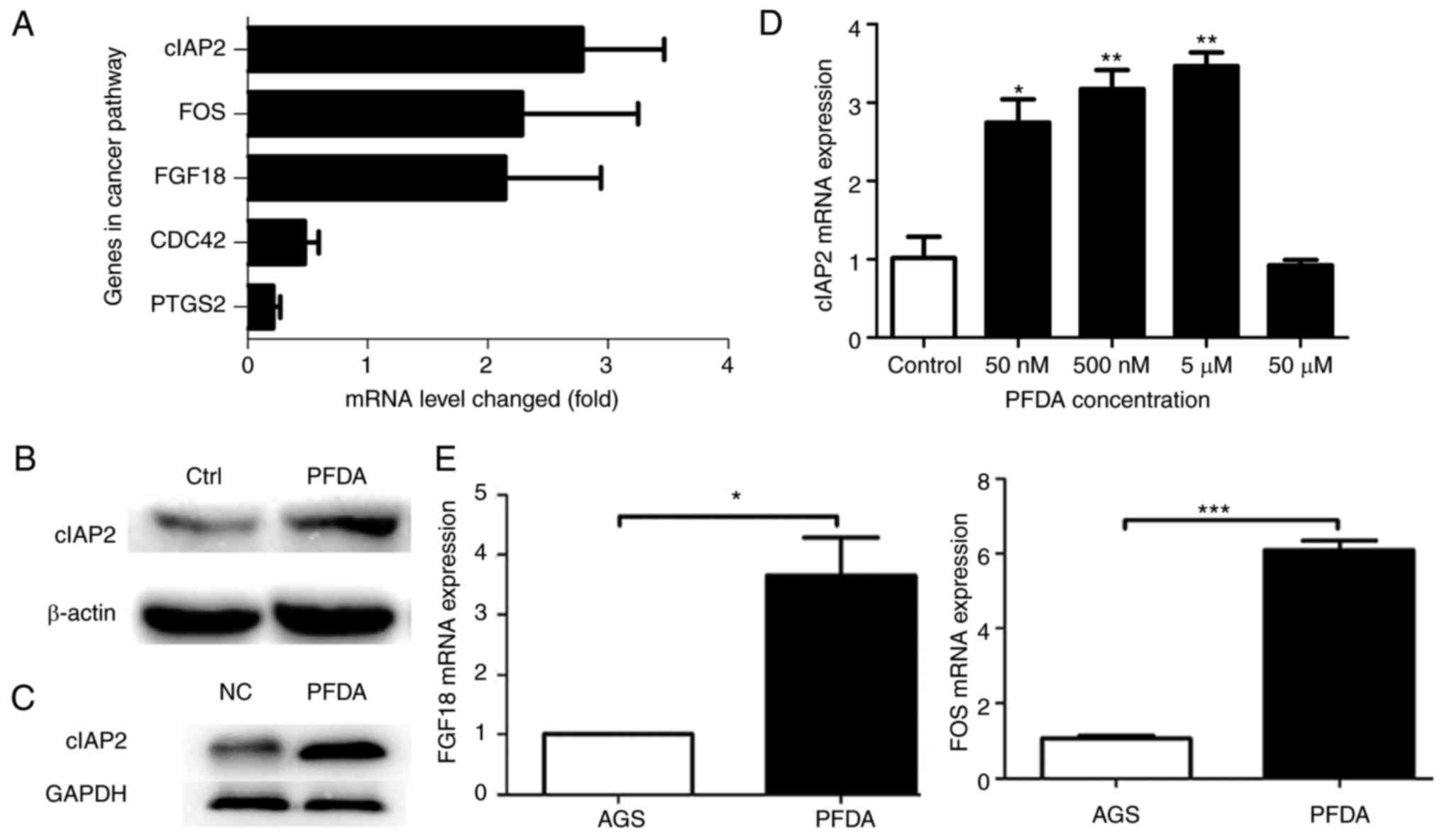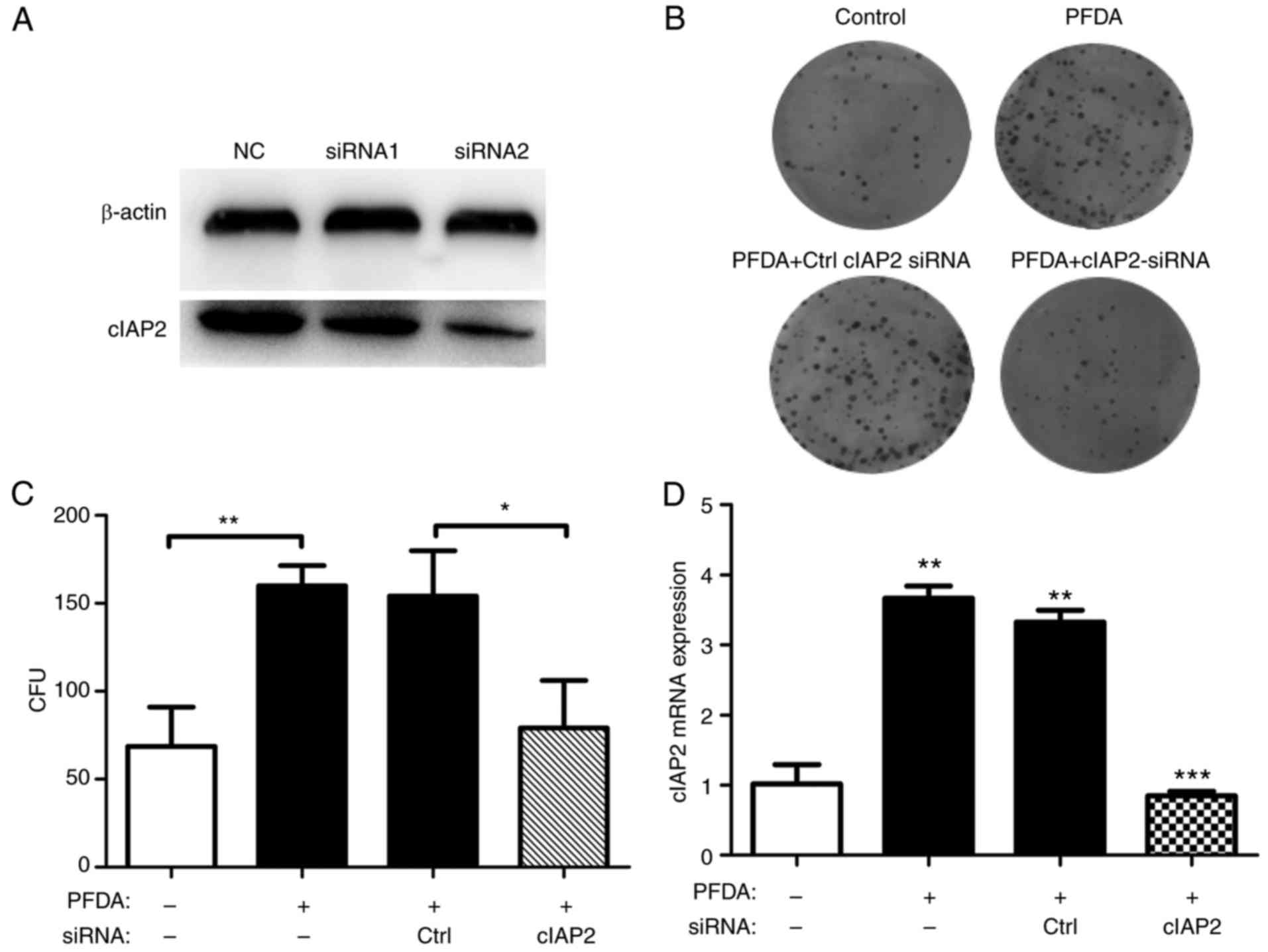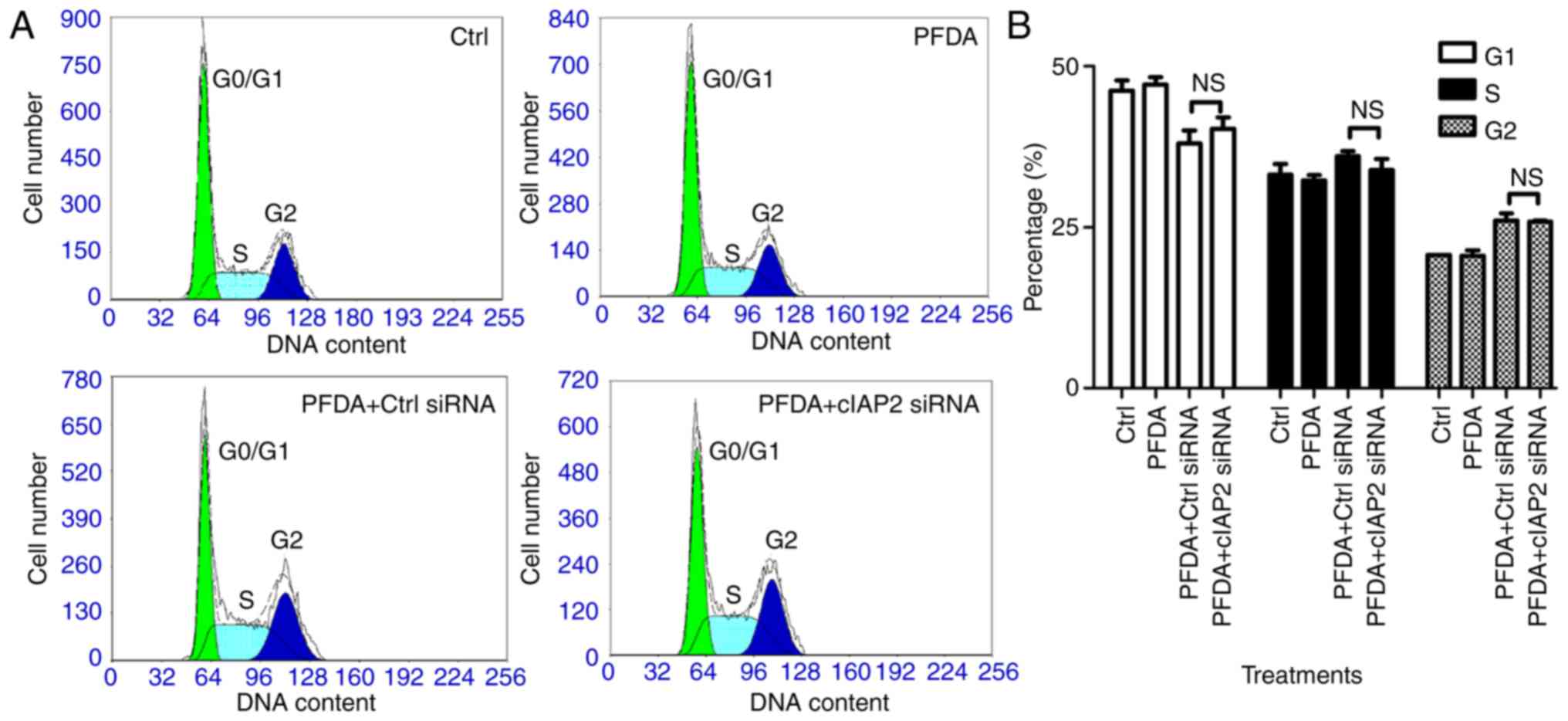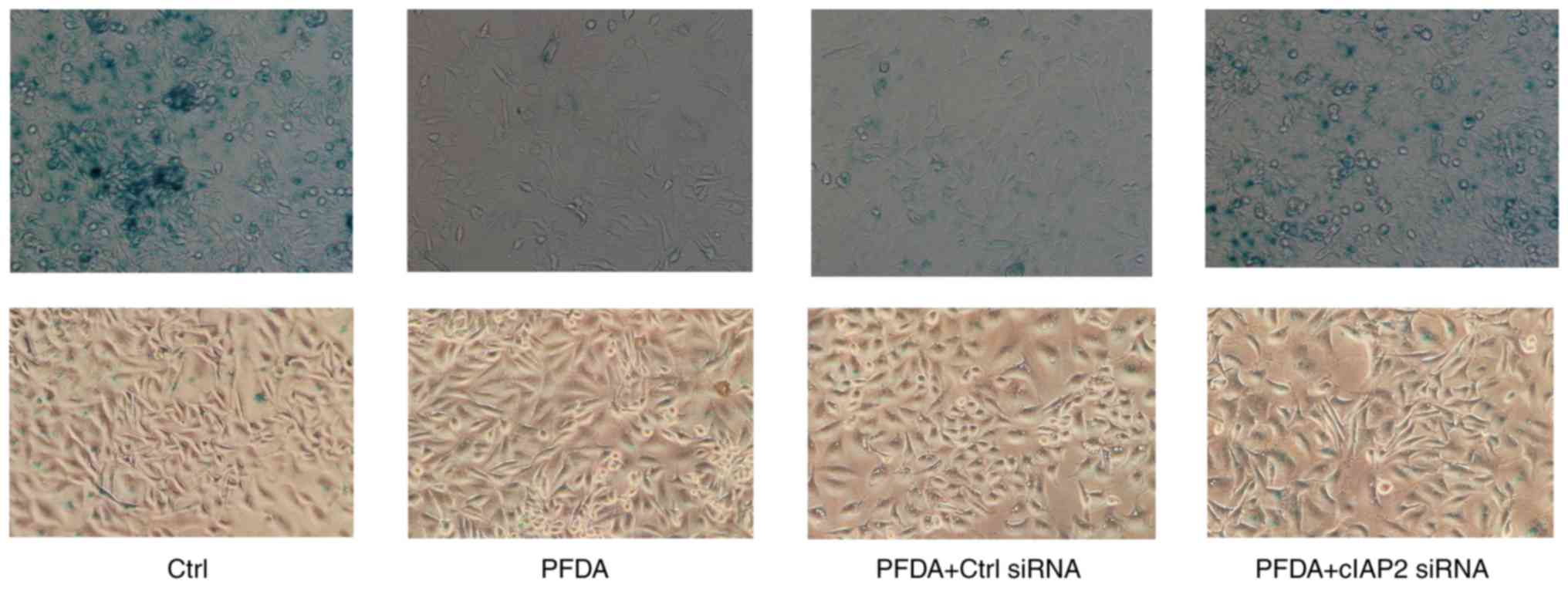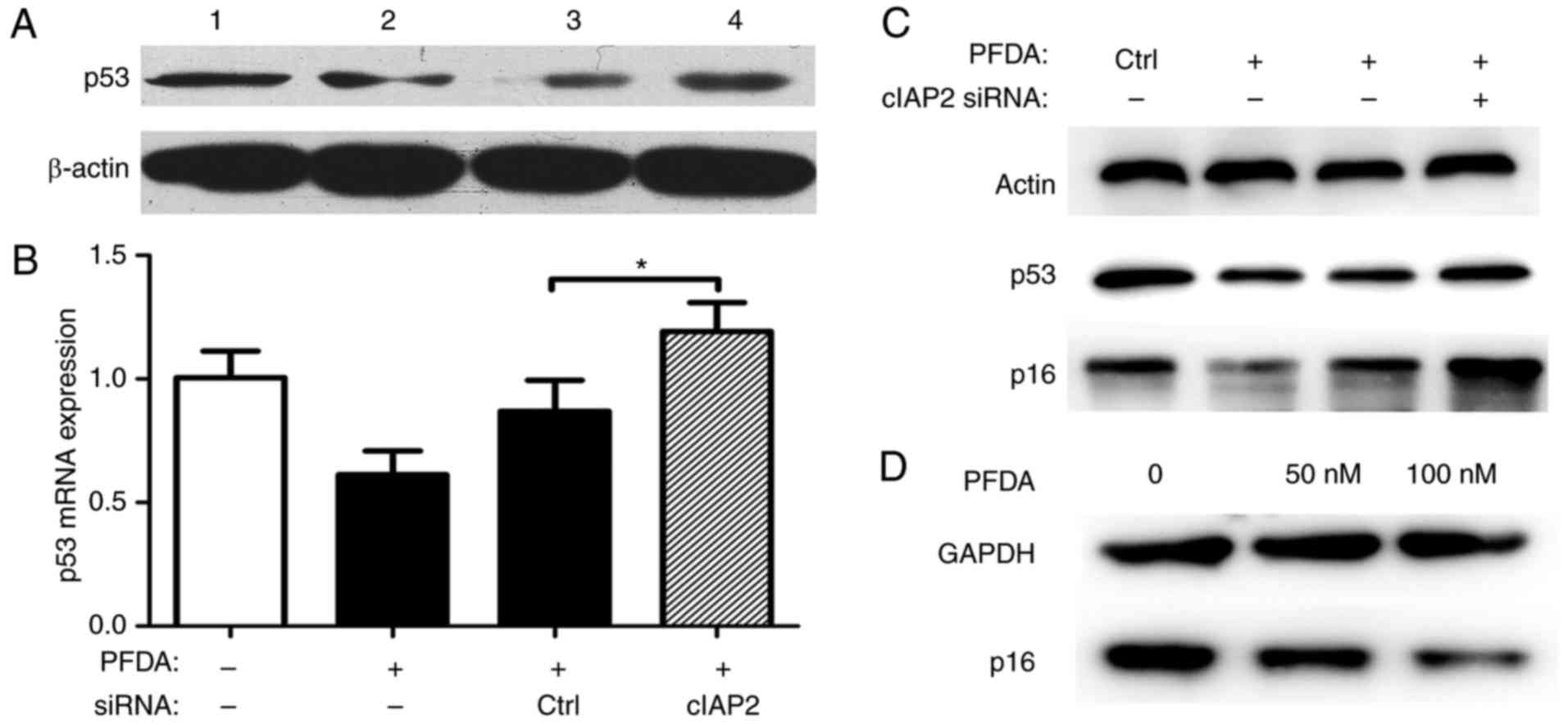|
1
|
Ashley DJ: Environmental factors in the
aetiology of gastric cancer. Br J Prev Soc Med. 23:187–189.
1969.PubMed/NCBI
|
|
2
|
Winkelstein WJ and Kantor S: Stomach
cancer. Positive association with suspended particulate air
pollution. Arch Environ Health. 18:544–547. 1969. View Article : Google Scholar : PubMed/NCBI
|
|
3
|
Zou X: Environmental pollution and
epidemic of common cancers in China. Ke Ji Dao Bao. 32:58–64.
2014.
|
|
4
|
Guenthner R and Vietork L: Surface active
materials from perfluorocarboxylic and perfluorosulfonilic acids.
I&ED Prod Res Dev. 1:165–169. 1962. View Article : Google Scholar
|
|
5
|
Shinoda K and Nomura T: Miscibility of
fluorocarbon and hydrocarbon surfactant in micelles and liquid
mixtures: Basic studies of oil repellent and fire extinguishing
agents. J Phys Chem. 8:365–369. 1980. View Article : Google Scholar
|
|
6
|
Mak YL, Taniyasu S, Yeung LW, Lu G, Jin L,
Yang Y, Lam PK, Kannan K and Yamashita N: Perfluorinated compounds
in tap water from China and several other countries. Environ Sci
Technol. 43:4824–4829. 2009. View Article : Google Scholar : PubMed/NCBI
|
|
7
|
Wang JM, YY P, YL S and YQ C:
Perfluorinated compounds pollution levels in snowfall of Beijing
urban area. Scientia Sinica Chimica. 41:900–906. 2011. View Article : Google Scholar
|
|
8
|
Calafat AM, Kuklenyik Z, Reidy JA, Caudill
SP, Tully JS and Needham LL: Serum concentrations of 11
polyfluoroalkyl compounds in the u.s. population: Data from the
national health and nutrition examination survey (NHANES). Environ
Sci Technol. 41:2237–2242. 2007. View Article : Google Scholar : PubMed/NCBI
|
|
9
|
Calafat AM, Wong LY, Kuklenyik Z, Reidy JA
and Needham LL: Polyfluoroalkyl chemicals in the U.S. population:
Data from the national health and nutrition examination survey
(NHANES) 2003–2004 and comparisons with NHANES 1999–2000. Environ
Health Perspect. 115:1596–1602. 2007. View Article : Google Scholar : PubMed/NCBI
|
|
10
|
Fei C, McLaughlin JK, Tarone RE and Olsen
J: Fetal growth indicators and perfluorinated chemicals: A study in
the Danish national birth cohort. Am J Epidemiol. 168:66–72. 2008.
View Article : Google Scholar : PubMed/NCBI
|
|
11
|
Nguyen VT, Gin KY, Reinhard M and Liu C:
Occurrence, fate, and fluxes of perfluorochemicals (PFCs) in an
urban catchment: Marina reservoir, Singapore. Water Sci Technol.
66:2439–2446. 2012. View Article : Google Scholar : PubMed/NCBI
|
|
12
|
Olsen GW, Church TR, Larson EB, van Belle
G, Lundberg JK, Hansen KJ, Burris JM, Mandel JH and Zobel LR: Serum
concentrations of perfluorooctanesulfonate and other
fluorochemicals in an elderly population from Seattle, Washington.
Chemosphere. 54:1599–1611. 2004. View Article : Google Scholar : PubMed/NCBI
|
|
13
|
Tao L, Kannan K, Aldous KM, Mauer MP and
Eadon GA: Biomonitoring of perfluorochemicals in plasma of New York
State personnel responding to the World trade center disaster.
Environ Sci Technol. 42:3472–3478. 2008. View Article : Google Scholar : PubMed/NCBI
|
|
14
|
Oono S, Matsubara E, Harada KH, Takagi S,
Hamada S, Asakawa A, Inoue K, Watanabe I and Koizumi A: Survey of
airborne polyfluorinated telomers in Keihan area, Japan. Bull
Environ Contam Toxicol. 80:102–106. 2008. View Article : Google Scholar : PubMed/NCBI
|
|
15
|
Skutlarek D, Exner M and Färber H:
Perfluorinated surfactants in surface and drinking waters. Environ
Sci Pollut Res Int. 13:299–307. 2006. View Article : Google Scholar : PubMed/NCBI
|
|
16
|
George ME and Andersen ME: Toxic effects
of nonadecafluoro-n-decanoic acid in rats. Toxicol Appl Pharmacol.
85:169–180. 1986. View Article : Google Scholar : PubMed/NCBI
|
|
17
|
Harris MW, Uraih LC and Birnbaum LS: Acute
toxicity of perfluorodecanoic acid in C57BL/6 mice differs from
2,3,7,8-tetrachlorodibenzo-p-dioxin. Fundam Appl Toxicol.
13:723–736. 1989. View Article : Google Scholar : PubMed/NCBI
|
|
18
|
Chinje E, Kentish P, Jarnot B, George M
and Gibson G: Induction of CYP4A subfamily by perfluorodecanoic
acid: The rat and guinea pig as susceptible and non-susceptible
species. Toxicol Lett. 71:69–75. 1994. View Article : Google Scholar : PubMed/NCBI
|
|
19
|
Kawashima Y, Kobayashi H, Miura H and
Kozuka H: Characterization of hepatic response of rat to
administration of perfluorooctanoic acid and perfluorodecanoic acid
at low levels. Toxicology. 99:169–178. 1995. View Article : Google Scholar : PubMed/NCBI
|
|
20
|
Reo NV, Narayanan L, Kling KB and
Adinehzadeh M: Perfluorodecanoic acid, a peroxisome proliferator,
activates phospholipase C, inhibits CTP: Phosphocholine
cytidylyltransferase, and elevates diacylglycerol in rat liver.
Toxicol Lett. 86:1–11. 1996. View Article : Google Scholar : PubMed/NCBI
|
|
21
|
Sterchele PF, Vanden Heuvel JP, Davis JW
II, Shrago E, Knudsen J and Peterson RE: Induction of hepatic
acyl-CoA-binding protein and liver fatty acid-binding protein by
perfluorodecanoic acid in rats. Lack of correlation with hepatic
long-chain acyl-CoA levels. Biochem Pharmacol. 48:955–966. 1994.
View Article : Google Scholar : PubMed/NCBI
|
|
22
|
Vanden Heuvel JP: Perfluorodecanoic acid
as a useful pharmacologic tool for the study of peroxisome
proliferation. Gen Pharmac. 27:1123–1129. 1996. View Article : Google Scholar
|
|
23
|
Olson CT and Andersen ME: The acute
toxicity of perfluorooctanoic and perfluorodecanoic acids in male
rats and effects on tissue fatty acids. Toxicol Appl Pharmacol.
70:362–372. 1983. View Article : Google Scholar : PubMed/NCBI
|
|
24
|
Langley AE: Effects of
perfluoro-n-decanoic acid on the respiratory activity of isolated
rat liver mitochondria. J Toxicol Environ Health. 29:329–336. 1990.
View Article : Google Scholar : PubMed/NCBI
|
|
25
|
Benninghoff AD, Bisson WH, Koch DC,
Ehresman DJ, Kolluri SK and Williams DE: Estrogen-like activity of
perfluoroalkyl acids in vivo and interaction with human and rainbow
trout estrogen receptors in vitro. Toxicol Sci. 120:42–58. 2011.
View Article : Google Scholar : PubMed/NCBI
|
|
26
|
Bookstaff RC, Moore RW, Ingall GB and
Peterson RE: Androgenic deficiency in male rats treated with
perfluorodecanoic acid. Toxicol Appl Pharmacol. 104:322–333. 1990.
View Article : Google Scholar : PubMed/NCBI
|
|
27
|
Gutshall DM, Pilcher GD and Langley AE:
Mechanism of the serum thyroid hormone lowering effect of
perfluoro-n-decanoic acid (PFDA) in rats. J Toxicol Environ Health.
28:53–65. 1989. View Article : Google Scholar : PubMed/NCBI
|
|
28
|
Van Rafelghem MJ, Inhorn SL and Peterson
RE: Effects of perfluorodecanoic acid on thyroid status in rats.
Toxicol Appl Pharmacol. 87:430–439. 1987. View Article : Google Scholar : PubMed/NCBI
|
|
29
|
Borges T, Peterson RE, Pitot HC, Robertson
LW and Glauert HP: Effect of the peroxisome proliferator
perfluorodecanoic acid on the promotion of two-stage
hepatocarcinogenesis in rats. Cancer Lett. 72:111–120. 1993.
View Article : Google Scholar : PubMed/NCBI
|
|
30
|
Upham BL, Deocampo ND, Wurl B and Trosko
JE: Inhibition of gap junctional intercellular communication by
perfluorinated fatty acids is dependent on the chain length of the
fluorinated tail. Int J Cancer. 78:491–495. 1998. View Article : Google Scholar : PubMed/NCBI
|
|
31
|
Nelson DL, Frazier DE Jr, Ericson JE, Tarr
MJ and Mathes LE: The effects of perfluorodecanoic acid (PFDA) on
humoral, cellular, and innate immunity in Fischer 344 rats.
Immunopharmacol Immunotoxicol. 14:925–938. 1992. View Article : Google Scholar : PubMed/NCBI
|
|
32
|
Klenow S, Heinemeyer G, Brambilla G,
Dellatte E, Herzke D and de Voogt P: Dietary exposure to selected
perfluoroalkyl acids (PFAAs) in four European regions. Food Addit
Contam Part A Chem Anal Control Expo Risk Assess. 30:2141–2151.
2013. View Article : Google Scholar : PubMed/NCBI
|
|
33
|
Dong T, Peng Y, Zhong N, Liu F, Zhang H,
Xu M, Liu R, Han M, Tian X, Jia J, et al: Perfluorodecanoic acid
(PFDA) promotes gastric cell proliferation via sPLA2-IIA.
Oncotarget. 8:50911–50920. 2017.PubMed/NCBI
|
|
34
|
Deitch AD, Law H and deVere White R: A
stable propidium iodide staining procedure for flow cytometry. J
Histochem Cytochem. 30:967–972. 1982. View Article : Google Scholar : PubMed/NCBI
|
|
35
|
Cristofalo VJ: SA-beta-Gal staining:
Biomarker or delusion. Exp Gerontol. 40:836–838. 2005. View Article : Google Scholar : PubMed/NCBI
|
|
36
|
Kurz DJ, Decary S, Hong Y and Erusalimsky
JD: Senescence-associated (beta)-galactosidase reflects an increase
in lysosomal mass during replicative ageing of human endothelial
cells. J Cell Sci. 113:3613–3622. 2000.PubMed/NCBI
|
|
37
|
Hartwell LH and Kastan MB: Cell cycle
control and cancer. Science. 266:1821–1828. 1994. View Article : Google Scholar : PubMed/NCBI
|
|
38
|
Woodburn JR: The epidermal growth factor
receptor and its inhibition in cancer therapy. Pharmacol Ther.
82:241–250. 1999. View Article : Google Scholar : PubMed/NCBI
|
|
39
|
Gyrd-Hansen M and Meier P: IAPs: From
caspase inhibitors to modulators of NF-kappaB, inflammation and
cancer. Nat Rev Cancer. 10:561–574. 2010. View Article : Google Scholar : PubMed/NCBI
|
|
40
|
Pedersen J, LaCasse EC, Seidelin JB,
Coskun M and Nielsen OH: Inhibitors of apoptosis (IAPs) regulate
intestinal immunity and inflammatory bowel disease (IBD)
inflammation. Trends Mol Med. 20:652–665. 2014. View Article : Google Scholar : PubMed/NCBI
|
|
41
|
Dai Z, Zhu WG, Morrison CD, Brena RM,
Smiraglia DJ, Raval A, Wu YZ, Rush LJ, Ross P, Molina JR, et al: A
comprehensive search for DNA amplification in lung cancer
identifies inhibitors of apoptosis cIAP1 and cIAP2 as candidate
oncogenes. Hum Mol Genet. 12:791–801. 2003. View Article : Google Scholar : PubMed/NCBI
|
|
42
|
Reardon DA, Michalkiewicz E, Boyett JM,
Sublett JE, Entrekin RE, Ragsdale ST, Valentine MB, Behm FG, Li H,
Heideman RL, et al: Extensive genomic abnormalities in childhood
medulloblastoma by comparative genomic hybridization. Cancer Res.
57:4042–4047. 1997.PubMed/NCBI
|
|
43
|
Vermeulen K, Van Bockstaele DR and
Berneman ZN: The cell cycle: A review of regulation, deregulation
and therapeutic targets in cancer. Cell Prolif. 36:131–149. 2003.
View Article : Google Scholar : PubMed/NCBI
|
|
44
|
Jin HS and Lee TH: Cell cycle-dependent
expression of cIAP2 at G2/M phase contributes to survival during
mitotic cell cycle arrest. Biochem J. 399:335–342. 2006. View Article : Google Scholar : PubMed/NCBI
|
|
45
|
Hayflick L and Moorhead PS: The serial
cultivation of human diploid cell strains. Exp Cell Res.
25:585–621. 1961. View Article : Google Scholar : PubMed/NCBI
|
|
46
|
Hayflick L: The limited in vitro lifetime
of human diploid cell strains. Exp Cell Res. 37:614–636. 1965.
View Article : Google Scholar : PubMed/NCBI
|
|
47
|
Brown JP, Wei W and Sedivy JM: Bypass of
senescence after disruption of p21CIP1/WAF1 gene
in normal diploid human fibroblasts. Science. 277:831–834. 1997.
View Article : Google Scholar : PubMed/NCBI
|
|
48
|
Xu HJ, Zhou Y, Ji W, Perng GS, Kruzelock
R, Kong CT, Bast RC, Mills GB, Li J and Hu SX: Reexpression of the
retinoblastoma protein in tumor cells induces senescence and
telomerase inhibition. Oncogene. 15:2589–2596. 1997. View Article : Google Scholar : PubMed/NCBI
|
|
49
|
Rogan EM, Bryan TM, Hukku B, Maclean K,
Chang AC, Moy EL, Englezou A, Warneford SG, Dalla-Pozza L and
Reddel RR: Alterations in p53 and p16INK4 expression and telomere
length during spontaneous immortalization of Li-Fraumeni syndrome
fibroblasts. Mol Cell Biol. 15:4745–4753. 1995. View Article : Google Scholar : PubMed/NCBI
|
|
50
|
Whitaker NJ, Bryan TM, Bonnefin P, Chang
AC, Musgrove EA, Braithwaite AW and Reddel RR: Involvement of RB-1,
p53, p16INK4 and telomerase in immortalisation of human cells.
Oncogene. 11:971–976. 1995.PubMed/NCBI
|
|
51
|
Capparelli C, Chiavarina B,
Whitaker-Menezes D, Pestell TG, Pestell RG, Hulit J, Andò S, Howell
A, Martinez-Outschoorn UE, Sotgia F, et al: CDK inhibitors
(p16/p19/p21) induce senescence and autophagy in cancer-associated
fibroblasts, ‘fueling’ tumor growth via paracrine interactions,
without an increase in neo-angiogenesis. Cell Cycle. 11:3599–3610.
2012. View Article : Google Scholar : PubMed/NCBI
|
|
52
|
Lin AW, Barradas M, Stone JC, van Aelst L,
Serrano M and Lowe SW: Premature senescence involving p53 and p16
is activated in response to constitutive MEK/MAPK mitogenic
signaling. Genes Dev. 12:3008–3019. 1998. View Article : Google Scholar : PubMed/NCBI
|
|
53
|
Helman A, Klochendler A, Azazmeh N, Gabai
Y, Horwitz E, Anzi S, Swisa A, Condiotti R, Granit RZ, Nevo Y, et
al: p16Ink4a-induced senescence of pancreatic beta cells
enhances insulin secretion. Nat Med. 22:412–420. 2016. View Article : Google Scholar : PubMed/NCBI
|
|
54
|
Marcoux S, Le ON, Langlois-Pelletier C,
Laverdière C, Hatami A, Robaey P and Beauséjour CM: Expression of
the senescence marker p16INK4a in skin biopsies of acute
lymphoblastic leukemia survivors: A pilot study. Radiat Oncol.
8:2522013. View Article : Google Scholar : PubMed/NCBI
|
|
55
|
Zhou X, Dong T, Fan Z, Peng Y, Zhou R,
Wang X, Song N, Han M, Fan B, Jia J and Liu S: Perfluorodecanoic
acid stimulates NLRP3 inflammasome assembly in gastric cells. Sci
Rep. 7:454682017. View Article : Google Scholar : PubMed/NCBI
|















